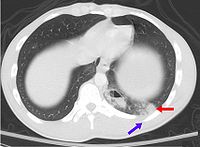
Photo from wikipedia
The purpose of this study was to evaluate the effect of generation and surface PEGylation of degradable polyester-based dendrimers nanocarriers on their interactions with an in vitro model of the… Click to show full abstract
The purpose of this study was to evaluate the effect of generation and surface PEGylation of degradable polyester-based dendrimers nanocarriers on their interactions with an in vitro model of the pulmonary epithelium as well as to assess the ability to formulate such carriers in propellant-based, portable oral-inhalation devices to determine their potential for local and systemic delivery of drugs to and through the lungs. Hydroxyl (-OH) terminated polyester dendrimers of generation 3 and 4 (G3, and G4) were synthesized using a divergent approach. G4 was surface-modified with PEG (1,000Da). All dendrimers and their building blocks were determined to be highly compatible with the model pulmonary epithelium, with toxicity profiles much more favorable than non-degradable polyamidoamine dendrimers (PAMAM). The transport of the species from the apical to basolateral side across polarized Calu-3 monolayers showed to be generation and surface-chemistry (PEGylation) dependent. The extent of the transport is modulated by their interaction with the polarized epithelium and their transient opening of the tight junctions. G3 was the one most efficiently internalized by the epithelium, and had a small impact on the integrity of the monolayer. On the other hand, the PEGylated G4 was the one least internalized by the polarized epithelium, and at the same time had a more pronounced transient impact on the cellular junctions, resulting in more efficient transport across the cell monolayer. PEGylation of the dendrimer surface played other roles as well. PEGylation modulated the degradation profile of the dendrimer, slowing the process in a step-wise fashion - first the PEG layer is shed and then the dendrimer starts degrading. PEGylation also helped increase the solvation of the nanocarriers by the hydrofluoroalkane propellant used in pressurized metered-dose inhalers, resulting in formulations with excellent dispersibility and aerosol quality (deep lung deposition of 88.5%), despite their very small geometric diameter. The combined in vitro and formulation performance results shown here demonstrated that degradable, modified polyester dendrimers may serve as a valuable platform that can be tailored to target the lung tissue for treating local diseases, or the circulation, using the lungs as pathway to the bloodstream.
Journal Title: International journal of pharmaceutics
Year Published: 2017
Link to full text (if available)
Share on Social Media: Sign Up to like & get
recommendations!